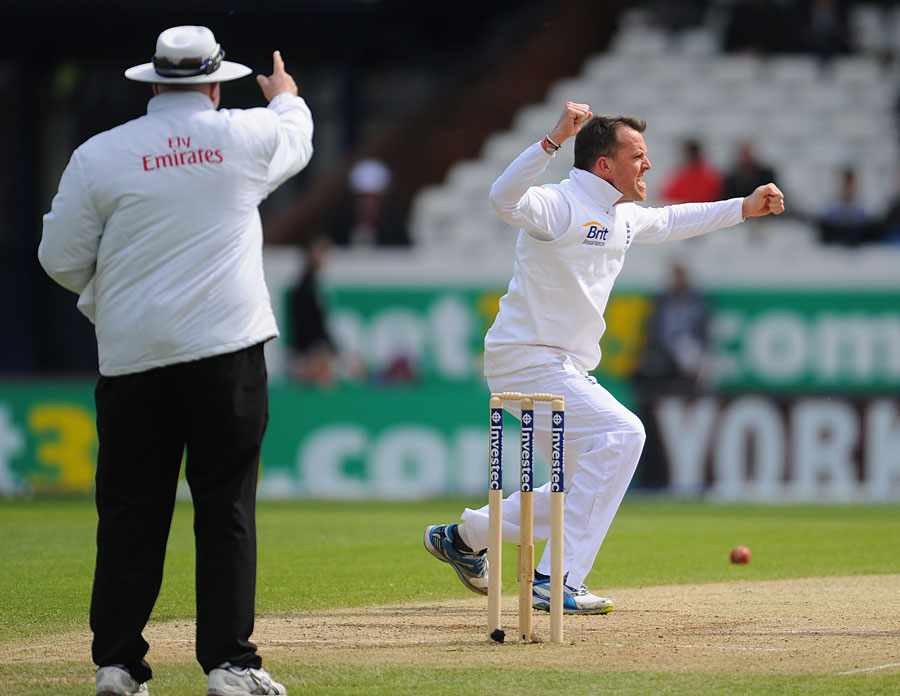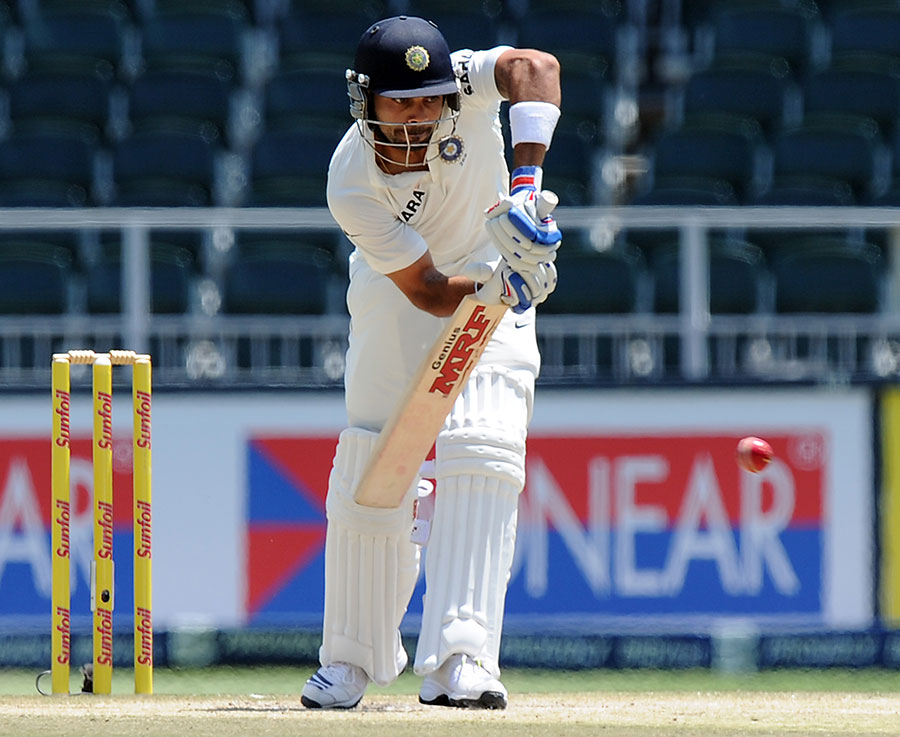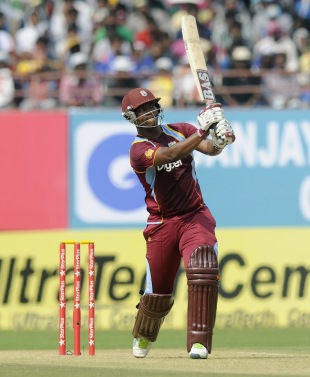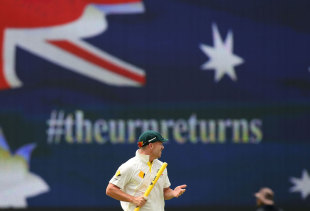The year just gone by has been one of surprises and swings of fortune
Sambit Bal January 6, 2014

Graeme Swann's retirement leaves a gaping hole in England's armour © Getty Images
About 20 minutes before tea on the third day of the first Ashes Test at the Gabba, a man hollered from high in the member's stand behind the sightscreen: "Cookeeey, give Bailey a single now, will ya."
Given George Bailey's batting partner, Michael Clarke, was on 99 at that point, it would have appeared to be a perfectly straight sentiment. Except, it carried delectable piquancy. Clarke had been dismissed fending off a bouncer in the first innings, and Cook had responded to his arrival in the second innings by gifting singles to his partner so that Stuart Broad could have a crack at him. From Cook, it had felt uncharacteristically cheeky, and to some Australians it had seemed mildly insulting.
But from there the story only headed one way. Clarke had emphatically swatted away the first bouncer from Broad to the midwicket boundary, squirted the next one for another four to fine leg, and grown Australia's ascendancy - gained by a burst of fast bowling of the sort Mitchell Johnson had always been thought capable of - to a decidedly winning position. Who could grudge the Australian fan a good-humoured jibe?
None of this, of course, had been even close to inevitable. England had arrived as favourites to win the Ashes a fourth time running, Australia's batting order was unsettled, and they had been forced to pick their second-choice bowling attack because a promising crop of young fast bowlers had been sidelined by injury. Johnson hadn't played a Test since March and was unlikely to have been picked had all the fast-bowling options been available.
But then, 2013 was that sort of year. It was a year of the unexpected, a year of twists, and a year of the possible.
Blanked out in India and squeezed dry in England, Australia have regained the Ashes with the pomp and swagger of their glory days. His leadership style and commitment to the Australian way questioned before the season, Clarke has led by example and with imagination and is a hero again. Zimbabwe have won a Test against Pakistan; and Pakistan have taken a Test off South Africa. England have tasted glory and despair in a matter of weeks. Nepal have qualified for the World Twenty20. Ishant Sharma won India the Champions Trophy. India's young batsmen have shown the technique, application and hunger for Test-match success not many had given them credit for possessing. South Africa almost chased down 458 at the Wanderers.
And the retirements - who would have seen them coming? Sachin Tendulkar's was the grandest and, given the size of his kingdom, the most stirring. But it was the most expected. Michael Hussey went abruptly, with his desire dimmed; Graeme Swann gave up mid-series, drained and worn out by defeat; and Jacques Kallis perhaps listened to his body. At the heart of it, retiring from sport is a deeply emotional decision. It isn't like retiring from a job that has run its course. It is giving up what you love most, what has defined you and forged your identity; it is about leaving home and stepping into the unknown. Some get the timing right, many don't, but to grudge them their decision would be missing the story.
****
Contemporary cricket captains are often accused of chasing the ball. That approach is perhaps reflective of batsman-friendly times, when bowling captains often have had to prey on the patience of batsmen in the absence of assistance from the conditions. Even when England were winning, Cook was often found posting a fielder where the last ball had been played.
But what about us cricket writers? How often do we scramble to catch up, to hurriedly construct a theory to explain an event that has left us befuddled, to appear wise and knowing even when we didn't see it coming? It is our job to make sense of events, but what if we are as confused as anyone else? How long ago was it that the English method - a combination of diligence, planning, efficiency and fortitude - was being held up as the template for sustained success? It wouldn't be outrageous to suggest that the Schofield Report, considered the blueprint for England's success, was scoured through more than once at Cricket Australia's headquarters.
Without doubt, England have looked broken for most of the Ashes series in Australia, but surely not everything about their cricket has turned rotten in the course of a couple of months?
" How long ago was it that the English method was being held up as the template for sustained success? Without doubt, England have looked broken for most of the Ashes series in Australia, but surely not everything about their cricket has turned rotten in the course of a couple of months?
Conversely, the Australian revival is now credited to them playing a brand of cricket reminiscent of their halcyon years, and Darren Lehman has been hailed as the man who fostered the egalitarian blokeyness that has got Australia playing with renewed fearlessness. Lehmann's tactical gaffes - picking Ashton Agar ahead of Nathan Lyon, batting David Warner in the middle order - have now conveniently receded from memory.
In sport, the truth is often simpler. And in cricket, fractions can make a difference. Australia's aggression in this series, it can be argued, is entirely accidental, because it was almost wholly dependent on a player who rediscovered his zest for bowling not in some Australian academy but in the unlikely environment of the Indian Premiere League. Warner and Brad Haddin often provided the ballast with the bat, but it was Johnson's pace that dramatically altered the tenor and the mood of the series. Australia fed on his raw machismo, and England, their batting mechanism messed up by his missiles, shrank by the day.
The first defining moment in the series came about almost by chance. Johnson started with a leg-side full toss, and his opening spell had lasted only three overs and yielded three fours. Ryan Harris provided the break by drawing an edge from Cook, and Clarke brought back Johnson to test Jonathan Trott's weakness against the short ball. Michael Carberry played out the first 12 balls from Johnson, but when he finally got a crack, Johnson's snarling bouncer found Trott's gloves. Trott survived the rest of the over, walking inside a couple of short balls and playing them down the leg side for runs, but Johnson had found his radar and Trott was palpably edgy. It was minutes before lunch and a race against time for Australia to squeeze in one more Johnson over. England's, particularly Trott's, sole objective at that point was to drag out the next over long enough to be able to retreat to temporary safety.
At this vital juncture of all-out aggression and extreme diffidence, Australia got their lucky break. Peter Siddle finished his over barely seconds before noon, but Aleem Dar took his position to allow Johnson one more over. He slammed it in short, Trott moved inside the line again, and his desperate jab ended feathering it to Haddin. Australia had struck a blow so resounding that the template for the rest of the series was drawn.
Or perhaps there is a simpler explanation for the scorelines in the back-to-back Ashes. Few Test teams are good enough to win away from home. The stats certainly bear this out. In 2013, only two - three counting the neutral venue of Dubai - away Test wins were recorded. Both against and in Zimbabwe.
****
The Ashes also saw the return of the Ugly Australian. Some hailed it as a good thing. Cricket had been dull in the series in England. The 3-0 scoreline, it was argued, flattered England. It was suggested that Australia had been too gentle, and incapable of seizing the big moments, as if the two things were related. Back home, Johnson provided the fire, but his team-mates also talked the talk, both on the field and off it. Warner taunted Trott by saying that he had seen fear in his eyes. Clarke was heard over the stump microphone threatening James Anderson with a broken arm.
The cricket world has always been divided over sledging. Some consider it to be against the grain of sport and, in fact, cowardly. Others consider it a legitimate tool in a tough and competitive environment where mental fortitude is tested as much as skills are.
Personally, I don't mind the odd stare and a bit of needle. But not all cricketers have the wit and the sensitivity to manage the line between teasing an opponent and descending into downright crudeness. It was wrong that Clarke got fined, because his comment was captured in isolation. But the whole thing was churlish. Trash-talking is okay in WWE, because the whole thing is fake, but if cricketers came to blows, something about the game would be lost.
Channel 9 later issued an apology to Clarke for a broadcast error, but I'd go the other way and keep the stump mikes on all the time. They were on during the India-South Africa Tests for most of the time and afforded fans an intimate view of the game.
There was MS Dhoni's delightful pep talk and instructions to Ravindra Jadeja; testy, but not ugly, exchanges between former IPL team-mates Dale Steyn and Rohit Sharma; and a charming conversation between Ajinkya Rahane and Ishant Sharma. Running out of partners while trying to prolong India's final innings in Durban, Rahane, alert to the requirement of farming the strike, asked his partner:
"Do ball khelega? [Will you face two balls?]"
"Nahin, ek kheloonga [No, I will play one]."
Rahane played out the fourth ball and took a single off the next.
The notion of privacy on a cricket field is an illusion. Cricket is an outdoor sport, played out before thousands and watched by millions. To be able hear what the players are thinking would be great for the viewers, and if the players wish to make fools of themselves, let them be judged for it.
****
Virat Kohli has started a fashion. Legends being hoisted on their team-mates' shoulders has become a standard salute ever since Kohli and his mates carried Tendulkar around Wankhede Stadium in the wake of India's World Cup win in 2011. Tendulkar himself was given the treatment twice more, by his Mumbai team-mates in Lahli in his final Ranji Trophy match, and finally in his farewell Test at the Wankhede. And so the South Africans weren't going to let Jacques Kallis go without a ride after his final Test appearance, in Durban.

India's golden age of batting has ended but it's not all gloom and doom yet © AFP
Tendulkar and Kallis have been the greatest cricketers of their era, and cricket is immeasurably poorer without them. With Tendulkar's departure, India lost the final link to their golden age of batting, and with Kallis gone, South Africa will have to learn the art of playing with 11 men again.
But every departure also grants an opportunity for renewal, and Kohli, who had already taken over the job of churning out one-day hundreds, provided a vision into the future with a first-innings hundred on a tough pitch in Johannesburg that was technically accomplished, temperamentally remarkable, and contained strokes of high pedigree. And in the same Test, Faf du Plessis, batting in Kallis' position, produced a virtuoso final-innings performance that very nearly carried South Africa to a record chase. It was the second time in his brief career that du Plessis had taken his team to safety against impossible odds, which makes him the ideal inheritor for Kallis. If only he could bowl.
Kallis' retirement came as a surprise, but the retirement that will be far more debilitating for his team was Swann's. He didn't get a farewell because he left abruptly and controversially. But though he could be accused of abandoning his team mid-way, it can be argued in his defence that the ship had already sunk. What he leaves behind, however, is emptiness. He was that rare article in English cricket: a match-winning Test spinner.
In many ways Swann was a freak. Not since James Laker have England produced an orthodox spinner as prolific for as long a period. And incredibly, Swann did it by staying loyal to the classical principles of offspin bowling when most of his peers were forced to reinvent the art by taking advantage of the 15-degree flex allowed by the ICC. You could call it brave and principled, or perhaps it was just something that suited him, but the fact is that with Swann you got what you saw. England will not only be a lesser team without him, but they may have to wait another eternity to find a match-winning spinner.
In part two, published on January 7, a look at the state of Test cricket, the Champions Trophy and the governance of the game
















